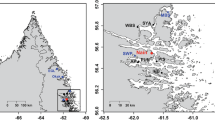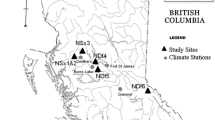Abstract
Microfibril angle (MFA) is an important factor in determining the mechanical properties of individual cells and wood as a whole. While some studies have described the variation of MFA within trees, little work has been done on the extent to which MFA is influenced by climate, despite it being known to respond to climatic events. Year-to-year variation in MFA and ring width was measured at high resolution by SilviScan-3® on 30 dated Picea crassifolia trees growing in the northeastern Tibetan plateau. The climate signals registered in MFA and ring width were analyzed using dendroclimatological methods. The response function of MFA accounted for 67% of total variance, of which 60% was explained by climate elements. The response function of ring width explained 57% total variance, 37% of which was explained by climate variables. MFA significantly responded to July–August temperatures, and to precipitation in March, May and September. Over the period 1987–2009 temperatures generally increase and appeared to have a greater influence on MFA. A decrease in the strength of the relationship between MFA and ring width over the period 1987–2009 was also observed. MFA offers the potential to build robust climate proxies. The strong climate sensitivity of MFA to increasing temperature or the observed changes in the MFA–ring width relationship may contribute to resolving the “divergence problem” in temperature reconstructions. As far as we are aware, this study is the first to show a strong climate response in MFA and suggests that it might be a useful climate proxy.






Similar content being viewed by others
References
Barnett JR, Bonham VA (2004) Cellulose microfibril angle in the cell wall of wood fibres. Biol Rev 79:461–472
Briffa K, Jones PD (1990) Basic chronology statistics and assessment. In: Cook E, Kairiukstis LA (eds) Methods of dendrochronology: applications in the environmental sciences. Kluwer, The Netherlands, pp 137–152
Büntgen U, Frank D, Wilson R, Carrer M, Urbinati C, Esper J (2008) Testing for tree-ring divergence in the European Alps. Glob Chang Biol 14:2443–2453
Cameron AD, Lee SJ, Livingston AK, Petty JA (2005) Influence of selective breeding on the development of juvenile wood in Sitka spruce. Can J For Res 35:2951–2960
Cave ID, Walker JCF (1994) Stiffness of wood in fast-grown plantation softwoods: The influence of microfibril angle. For Prod J 44:43–48
Chave J, Coomes D, Jansen S, Lewis SL, Swenson NG, Zanne AE (2009) Towards a worldwide wood economics spectrum. Ecol Lett 12:351–366
Cook ER (1985) A time-series analysis approach to tree-ring standardization. PhD thesis, The University of Arizona, USA
Cook ER, Kairiukstis LA (1990) Methods of dendrochronology. Application in environmental sciences. Kluwer Academic Publishers, Dordrecht
Cook ER, Woodhouse CA, Eakin CM, Meko DM, Stahle DW (2004) Long-term aridity changes in the western United States. Science 306:1015–1018
D’Arrigo R, Wilson R, Liepert B, Cherubini P (2008) On the “divergence problem” in northern forests: a review of tree-ring evidence and possible causes. Glob Planet Chang 60:289–305
Donaldson L (1992) Within- and between-tree variation in microfibril angle in Pinus radiata. N Z J For Sci 22:77–86
Donaldson L (2008) Microfibril angle: measurement, variation and relationships—review. IAWA J 29:345–386
Drew DM, Downes GM, O’Grady AP, Read J, Worledge D (2009) High resolution temporal variation in wood properties in irrigated and non-irrigated Eucalyptus globulus. Ann For Sci 66:406
Echols RM (1955) Linear relationships of fibrillar angle to tracheid length and the genetic control of tracheid length in slash pine. Trop Woods 102:11–22
Esper J, Cook ER, Schweingruber FH (2002) Low-frequency signals in long tree-ring chronologies and the reconstruction of past temperature variability. Science 295:2250–2253
Evans R (1994) Rapid measurement of the transverse dimensions of tracheids in radial wood sections from Pinus radiata. Holzforschung 48:168–172
Evans R (1999) A variance approach to the x ray diffractometric estimation of microfibril angle in wood. Appita J 24:283–289
Evans R, Ilic J (2001) Rapid prediction of wood stiffness from microfibril angle and density. For Prod J 51:53–57
Evans R, Stuart SA, Vander TJ (1996) Microfibril angle scanning of increment cores by x-ray densitometry. Appita J 49:411–414
Evans R, Kibblewhite RP, Stringer SL (2001) Variation in microfibril angle, density and fibre orientation in twenty-nine Eucalyptus nitens trees. Appita J 535:450–457
Fang KY, Gou XH, Chen FH, Peng JF, D’Arrigo R, Wright W, Li MH (2009) Response of regional tree-line forests to climate change: evidence from the northeastern Tibetan Plateau. Trees 23:1321–1329
Fonti P, García-González I (2008) Earlywood vessel size of oak as potential proxy for spring precipitation in mesic sites. J Biogeogr 35:2249–2257
Fonti P, Arx G, García-González I, Eilmann B, Sass-Klaassen U, Gärtner H, Eckstein D (2010) Studying global change through investigation of the plastic responses of xylem anatomy in tree rings. New Phytol 185:42–53
Fritts HC (2001) Tree rings and climate. Blackburn Press, Caldwell
Fritts HC, Vaganov EA, Sviderskaya IV, Shashkin AV (1991) Climatic variation and tree-ring structure in conifers: empirical and mechanistic models of tree-ring width, number of cells, cell size, cell-wall thickness and wood density. Clim Res 1:97–116
Gou X, Chen F, Yang M, Peng J, Jin L (2005) Climatic response of thick leaf spruce (Picea crassifolia) tree-ring width at different elevations over Qilian Mountains, northwestern China. J Arid Environ 61:513–524
Guiot J (1991) The bootstrapped response function. Tree-Ring Bull 51:39–41
He ZB, Zhao WZ, Zhang LJ, Liu H, Zhang ZH (2009) Logging disturbance and the restoration process of Picea crassifolia forest in Qilian Mountain. Scientia Silvae Sinicae 45:12–16 (Chinese)
Herman M, Dutilleul P, Avella-Shaw T (1999) Growth rate effects on intra-ring and inter-ring trajectories of microfibril angle in Norway spruce (Picea abies). IAWA J 20:3–21
Hiller CH, Brown RS (1967) Comparison of dimensions and fibril angles of loblolly pine tracheids formed in wet or dry growing seasons. Am J Bot 54:453–460
Holmes RL (1983) Computer-assisted quality control in tree-ring dating and measurement. Tree-Ring Bull 43:69–95
IPCC (2007) Climate change 2007: the physical science basis. Contribution of Working Group I to the Fourth Assessment Report of the Intergovernmental Panel on Climate Change. Cambridge University Press, Cambridge
Jurbergs KA (1963) Determining fibre length, fibrillar angle and spring wood-summer wood ratio in slash pine. For Sci 9:181–187
Lebourgeois F (2000) Climatic signals in earlywood, latewood and total ring width of Corsican pine from western France. Ann For Sci 57:155–164
Liang EY, Shao XM, Eckstein D, Huang L, Liu XH (2006) Topography- and species-dependent growth responses of Sabina przewalskii and Picea crassifolia to climate on the northeast Tibetan Plateau. For Ecol Manag 236:268–277
Lindström H, Evans JW, Verrill SP (1998) Influence of cambial age and growth conditions on microfibril angle in young Norway spruce (Picea abies [L.] Karst.). Holzforschung 52:573–581
Liu XC (1992) Picea crassifolia. Lanzhou University Press, Lanzhou, China
Loehle C (2009) A mathematical analysis of the divergence problem in dendroclimatology. Clim Chang 94:233–245
Long JM, Conn A, Batchelor WJ, Evans R (2000) Comparison of methods to measure fibril angle in wood fibres. Appita J 533:206–209
Lundgren C (2004) Microfibril angle and density patterns of fertilized and irrigated Norway spruce. Silva Fenn 38:107–117
Manly BFJ (1997) Randomization, bootstrap and Monte Carlo methods in biology. Chapman, London
Mcmillin CW (1973) Fibril angle of loblolly pine wood as related to specific gravity, growth rate and distance from the pith. Wood Sci Technol 7:251–255
Niklas KJ (1992) Plant biomechanics: an engineering approach to plant form and function. The University of Chicago Press, Chicago
Oberhuber W, Kofler W, Pfeifer K, Seeber A, Gruber A, Wieser G (2008) Long-term changes in tree-ring—climate relationships at Mt. Patscherkofel (Tyrol, Austria) since the mid 1980s. Trees 22:31–40
Okuyama T, Toshida M, Yamamoto H (1995) An estimation of the turgor pressure changes as one of the factors of growth stress generation in cell walls. Mokuzai Gakkaishi 41:114–117
Panayotov M, Bebi P, Trouet V, Yurukov S (2010) Climate signal in tree-ring chronologies of Pinus peuce and Pinus heldreichii from the Pirin Mountains in Bulgaria. Trees 24:479–490
Pant GB, Kumar RK, Borgaonkar HP, Okada N, Fujiwara T, Yamashita K (2000) Climatic response of Cedrus deodara tree-ring parameters from two sites in the western Himalaya. Can J For Res 30:1127–1135
Panyushkina P, Hughes M, Vaganov E, Munro M (2003) Summer temperature in northeastern Siberia since 1642 reconstructed from tracheid dimensions and cell numbers of Larix cajanderi. Can J For Res 33:1905–1914
Pedini M (1992) The variation in the microfibrillar angle within the juvenile wood of Sitka spruce. IAWA Bull New Ser 13:261
Phillips EWJ (1941) The inclination of fibrils in the cell wall and its relation to the compression of timber. Emp For J 20:74–78
Qiang WY, Wang XN, Chen T, Feng HY, An LZ, He YQ, Wang G (2003) Variations of stomatal density and carbon isotope values of Picea crassifolia at different altitudes in the Qilian Mountains. Trees 17:258–262
Sarén MP, Serimaa R, Andersson S, Saranpää P, Keckes J, Fratzl P (2004) Effect of growth rate on mean microfibril angle and cross-sectional shape of tracheids of Norway spruce. Trees 18:354–362
Todaro L, Andreu L, Alessandro CM, Gutierrez E, Cherubini P, Saracino A (2007) Response of Pinus leucodermis to climate and anthropogenic activity in the National Park of Pollino (Basilicata, southern Italy). Biol Conserv 137:507–519
Treydte K, Schleser GH, Helle G, Frank DC, Winiger M, Haug GH, Esper J (2006) The twentieth century was the wettest period in northern Pakistan over the past millennium. Nature 440:1179–1182
Trouet V, Esper J, Graham NE, Baker A, Scourse JD, Frank DC (2009) Persistent positive North Atlantic Oscillation mode dominated the Medieval Climate Anomaly. Science 324:78–80
Wilmking M, Juday GP, Barber VA, Zaldw HSJ (2004) Recent climate warming forces contrasting growth responses of white spruce at treeline in Alaska through temperature thresholds. Glob Chang Biol 10:1724–1736
Wilson BF, Archer RA (1979) Tree design: some biological solutions to mechanical problems. Bioscience 9:293–298
Wimmer R, Downes GM (2003) Temporal variation of the ring width-wood density relationship in Norway spruce growing under two levels of anthropogenic disturbance. IAWA J 24:53–61
Wimmer R, Grabner M (2000) A comparison of tree-ring features in Picea abies as correlated with climate. IAWA J 21:403–416
Wimmer R, Downes GM, Evans R (2002) Temporal variation of microfibril angle in Eucalyptus nitens grown in different irrigation regimes. Tree Physiol 227:449–457
Xiong L, Okada N, Fujiwara T, Ohta S, Palmer JG (1998) Chronology development and climate response analysis of different New Zealand pink pine (Halocarpus biformis) tree-ring parameters. Can J For Res 28:566–573
Xu JM, Lu JX, Bao FC, Huang RF, Liu XD, Evans R, Zhao YK (2011) Response of wood density of Picea crassifolia in Qilian Mountains of northwestern China to climate change. J Beijing For Univ 33(5):115–121 (Chinese)
Youming X, Han L, Chunyun X (1998) Genetic and geographic variation in microfibril angle of loblolly pine in 31 provenances. In: Butterfield BG (ed) Microfibril angle in wood. University of Canterbury, Christchurch
Zhang YX, Wilmking M (2010) Divergent growth responses and increasing temperature limitation of Qinghai spruce growth along an elevation gradient at the northeast Tibet Plateau. For Ecol Manag 260:1076–1082
Zhang YX, Wilmking M, Gou XH (2009) Changing relationships between tree growth and climate in Northwest China. For Ecol 201:39–50
Acknowledgments
This work was funded by the State Forestry Administration of China (No. 200804001) and the National Natural Science Foundation of China (No. 30825034). The Academy of Water Resource Conservation Forest of Qilian Mountains in Gansu provided appreciable support for fieldwork. Thanks to Winston Liew in CSIRO for technical assistance with sample preparation and measurement. We thank the anonymous referees for their comments and suggestions which have greatly improved this paper.
Author information
Authors and Affiliations
Corresponding author
Additional information
Communicated by S. Leavitt.
Rights and permissions
About this article
Cite this article
Xu, J., Lu, J., Bao, F. et al. Cellulose microfibril angle variation in Picea crassifolia tree rings improves climate signals on the Tibetan plateau. Trees 26, 1007–1016 (2012). https://doi.org/10.1007/s00468-012-0678-7
Received:
Revised:
Accepted:
Published:
Issue Date:
DOI: https://doi.org/10.1007/s00468-012-0678-7




